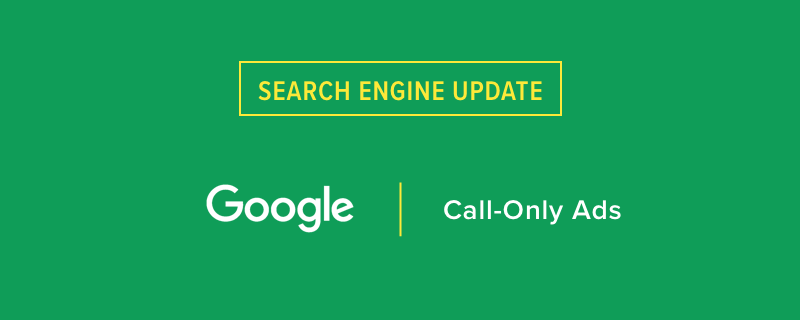Noticed anything different when setting up call-only ad campaigns in Google Ads? In December, Google made changes to their call-only ads policy. While the changes may appear relatively minor, they have implications for advertisers wishing to use this type of ad. These updates are in line with Google’s philosophy of providing a smooth customer journey and ensuring that people engaging with ads on their search engine are finding what they want.
These changes also reflect Google’s ongoing effort to curb bad behavior by lead generators, who are interested in selling leads, not protecting customers or brands. In November 2016, Google issued a policy update restricting the use of trademarks by lead generators in paid search. The recent call-only ad updates will make it more difficult for third-party lead generators to operate click-to-call ads, and therefore are part of this longer-term effort by Google to control lead generators.
What are call-only ads?
You will see call-only ads on the SERP when you do a search like “drywall repair” on your mobile device. They are the text ads that include a phone number and are designed to encourage calls rather than clicks.
See the SERP I found when I did that exact search on my mobile device. The result for Dahl’s Drywall is a call-only ad.
 What are Google’s changes?
What are Google’s changes?
The first change is that “Service providers will now be required to use their actual business name in call-only ads. Service providers can no longer advertise with a business name that doesn’t represent their specific business or clearly disambiguate from similar businesses.”
Prior to this update, a company could use a generic or location-based business name in the call-only campaign when they advertised, even if their actual business name was different. In the update, Google gives the example of “Mountain View Plumbers.” There are of course many plumbers operating in the Mountain View, CA area. In the past, a company named “Jerry’s Plumbing” with a website www.jerrysplumbing.com could set up a call-only ad using the name “Mountain View Plumbers.” A customer searching for plumbers in Mountain View via a Google search would find the ad, and then click to call. The customer wouldn’t know if they were speaking with Jerry’s Plumbing, or a central dispatcher fielding calls and finding plumbers in Mountain View. In short, it created a suboptimal experience for the customer. Now with this update, Jerry’s Plumbing will have to use their company name in the ad.
The second change states, “When answering calls from users who’ve clicked on their call-only ad, advertisers must begin the call by stating their business name, as it appears in their call-only ads.” Again, using the example of Jerry’s Plumbing, if a customer clicked on the Jerry’s Plumbing ad, the person answering the phone would have to say something to the effect of “Jerry’s Plumbing. How can I help you?”
What are the implications of the changes?
With these two changes, Google is clearly saying that they want the ads placed by the brand to match the actual brand and they are continuing to put pressure on lead generators. Some lead generators sell consumer information to multiple providers, which results in a poor user experience for consumers; they become the recipients of an avalanche of contacts from each individual provider.
These changes also reflect Google’s continued focus on cracking down on deceptive providers of onsite local services. For example, Google has made a series of changes in the last few years affecting specific industries such as locksmiths, plumbers, and garage door repair services with the introduction of advanced verification processes.
Google’s policy suggests focus on local services, but it can absolutely be extended to a wide range of services that typically require a phone call to initiate or conclude. On initial review, it appears Google’s enforcement outside of local services has been inconsistent.
See, for example, the SERP below. The ad at the bottom from offerscabletv.com is most likely a lead generator. When I called the number listed in the ad during regular business hours, I heard a generic recording saying, "The party you are trying to reach cannot take your call. Please leave a message." The message did not include any mention of the business name "Offers Cable TV."
 But when the policy is properly enforced, consumers are less likely to get tricked. They will clearly know who they are talking to on the phone when they click-to-call.
But when the policy is properly enforced, consumers are less likely to get tricked. They will clearly know who they are talking to on the phone when they click-to-call.
Google has a long-standing policy that they will only run one ad from a brand on a particular SERP. Some advertisers have partnered with lead generation providers to run multiple ads on a SERP that effectively promote the same offering, like the cable internet example we talked about above. The new policy may reduce the number of lead generator ads running alongside a brand’s own ads that promote the same services from the same provider, as the lead generators will need to be transparent about which company they are promoting.
How do these changes impact paid search monitoring programs?
Prior to this update, it was very difficult for brand owners to issue takedown requests to Google in cases where they found their brand name being used to entice clicks. These changes give greater control to brand owners. They can now more easily monitor and take down ads that divert customers to competitors and other third-parties.
Want to learn more about how BrandVerity can help you protect your brand and trademark? We are happy to walk you through your brand’s live data and show you how easy it is to clean up the SERP on searches of your branded terms.


